A Potential Link between Space Weather and Atmospheric Parameters Variations: A Case Study of November 2021 Geomagnetic Storm
Abstract
:1. Introduction
2. Data and Methods
2.1. Solar Wind and Interplanetary Magnetic Field Data
2.2. Atmospheric Data
2.3. The Relationship between SW and Atmospheric Parameters
3. Results
3.1. Changes in Tropospheric and Stratospheric Parameters during the Geomagnetic Storm
3.2. On the Possible Link between Solar Wind Turbulence with Joule Heating
4. Discussion
5. Conclusions
- The atmospheric parameters temperature (T), specific humidity (Q), and zonal wind (U) seem to respond to the solar wind-driven electrodynamics of the polar cap regions and in both the hemispheres during the geomagnetic storm. On the contrary, meridional wind (V) appear unaffected by the solar wind–magnetosphere coupling process.
- The atmospheric parameters T, Q, and U respond approximately within one day to the geomagnetic activity: the shorter delay in the northern hemisphere compared to the southern one may be attributed to the stratospheric polar vortex in the northern hemisphere.
- The latitudinal investigation suggests that the temperature has a major correspondence with the polar cap potential difference near the auroral regions, where the electrodynamic activity, due to solar wind–atmosphere coupling processes, maximizes.
- During the storm’s main phase, the solar wind turbulence state seems to play a role in the transfer of energy from the interplanetary medium into the magnetosphere, in a complex way, causing additional Joule heating effects.
Author Contributions
Funding
Data Availability Statement
Acknowledgments
Conflicts of Interest
Abbreviations
| B | Interplanetary magnetic field |
| E | Electric potential |
| ECMWF | European Centre for Medium-Range Weather Forecasts |
| FACs | Field-Aligned Currents |
| F | FACs intensity |
| GEC | global electric circuit |
| IEF | Interplanetary Electric Field |
| J | Joule heating |
| MC | Monte Carlo |
| Q | specific humidity |
| R | cross-covariance |
| SCHA | Spherical Cap Harmonic Analysis |
| SSC | Storm Sudden Commencement |
| SuperDARN | Super Dual Auroral Radar Network |
| SW | Solar Wind |
| T | Temperature |
| U | zonal wind velocity |
| V | meridional wind velocity |
| SW velocity | |
| SW density | |
| W05 | Weimer 2005 |
| geographic latitude | |
| geographic longitude | |
| normalized cross helicity | |
| normalized residual energy |
References
- Yiğit, E.; Knížová, P.K.; Georgieva, K.; Ward, W. A review of vertical coupling in the Atmosphere-Ionosphere system: Effects of waves, sudden stratospheric warmings, space weather, and of solar activity. J. Atmos. Sol.-Terr. Phys. 2016, 141, 1–12. [Google Scholar] [CrossRef]
- Seppälä, A.; Matthes, K.; Randall, C.E.; Mironova, I.A. What is the solar influence on climate? Overview of activities during CAWSES-II. Eur. J. Nucl. Med. Mol. Imaging 2014, 1, 24. [Google Scholar] [CrossRef]
- Mironova, I.A.; Aplin, K.L.; Arnold, F.; Bazilevskaya, G.A.; Harrison, R.G.; Krivolutsky, A.A.; Nicoll, K.A.; Rozanov, E.V.; Turunen, E.; Usoskin, I.G. Energetic Particle Influence on the Earth’s Atmosphere. Space Sci. Rev. 2015, 194, 1–96. [Google Scholar] [CrossRef]
- Tinsley, B.A.; Zhou, L. Initial results of a global circuit model with variable stratospheric and tropospheric aerosols. J. Geophys. Res. Atmos. 2006, 111, D16205. [Google Scholar] [CrossRef]
- Tinsley, B.A.; Burns, G.B.; Zhou, L. The role of the global electric circuit in solar and internal forcing of clouds and climate. Adv. Space Res. 2007, 40, 1126–1139. [Google Scholar] [CrossRef]
- Lam, M.M.; Tinsley, B.A. Solar wind-atmospheric electricity-cloud microphysics connections to weather and climate. J. Atmos. Sol.-Terr. Phys. 2016, 149, 277–290. [Google Scholar] [CrossRef]
- Lei, J.; Thayer, J.P.; Forbes, J.M.; Sutton, E.K.; Nerem, R.S.; Temmer, M.; Veronig, A.M. Global thermospheric density variations caused by high-speed solar wind streams during the declining phase of solar cycle 23. J. Geophys. Res. Space Phys. 2008, 113, A11303. [Google Scholar] [CrossRef]
- Thayer, J.P.; Lei, J.; Forbes, J.M.; Sutton, E.K.; Nerem, R.S. Thermospheric density oscillations due to periodic solar wind highspeed streams. J. Geophys. Res. Space Phys. 2008, 113, A06307. [Google Scholar] [CrossRef]
- Jiang, G.; Wang, W.; Xu, J.; Yue, J.; Burns, A.G.; Lei, J.; Mlynczak, M.G.; Rusell, J.M. Responses of the lower thermospheric temperature to the 9-day and 13.5-day oscillations of recurrent geomagnetic activity. J. Geophys. Res. Space Phys. 2014, 119, 4841–4859. [Google Scholar] [CrossRef]
- Francia, P.; Regi, M.; De Lauretis, M. Signatures of the ULF geomagnetic activity in the surface air temperature in Antarctica. J. Geophys. Res. Space Phys. 2015, 120, 2452–2459. [Google Scholar] [CrossRef]
- Regi, M.; Lauretis, M.D.; Redaelli, G.; Francia, P. ULF geomagnetic and polar cap potential signatures in the temperature and zonal wind reanalysis data in Antarctica. J. Geophys. Res. Space Phys. 2016, 121, 286–295. [Google Scholar] [CrossRef]
- Regi, M.; Redaelli, G.; Francia, P.; Lauretis, M.D. ULF geomagnetic activity effects on tropospheric temperature, specific humidity, and cloud cover in Antarctica, during 2003–2010. J. Geophys. Res. Atmos. 2017, 122, 6488–6501. [Google Scholar] [CrossRef]
- Voiculescu, M.; Usoskin, I.; Condurache-Bota, S. Clouds blown by the solar wind. Environ. Res. Lett. 2013, 8, 045032. [Google Scholar] [CrossRef]
- Prikryl, P.; Iwao, K.; Muldrew, D.B.; Rušin, V.; Rybanský, M.; Bruntz, R. A link between high-speed solar wind streams and explosive extratropical cyclones. J. Atmos. Sol.-Terr. Phys. 2016, 149, 219–231. [Google Scholar] [CrossRef]
- Elsner, J.B.; Jagger, T.H. United States and Caribbean tropical cyclone activity related to the solar cycle. Geophys. Res. Lett. 2008, 35, L18705. [Google Scholar] [CrossRef]
- Todorović, N.; Vujović, D. Links between geomagnetic activity and atmospheric cold fronts passage over the Belgrade region, Serbia. Meteorol. Appl. 2022, 29, e2107. [Google Scholar] [CrossRef]
- Regi, M.; Perrone, L.; Del Corpo, A.; Spogli, L.; Sabbagh, D.; Cesaroni, C.; Alfonsi, L.; Bagiacchi, P.; Cafarella, L.; Carnevale, G.; et al. Space Weather Effects Observed in the Northern Hemisphere during November 2021 Geomagnetic Storm: The Impacts on Plasmasphere, Ionosphere and Thermosphere Systems. Remote Sens. 2022, 14, 5765. [Google Scholar] [CrossRef]
- Heelis, R.A.; Lowell, J.K.; Spiro, R.W. A model of the high-latitude ionospheric convection pattern. J. Geophys. Res. Space Phys. 1982, 87, 6339–6345. [Google Scholar] [CrossRef]
- Weimer, D.R. Improved ionospheric electrodynamic models and application to calculating Joule heating rates. J. Geophys. Res. 2005, 110, A05305. [Google Scholar] [CrossRef]
- Weimer, D.R. Predicting surface geomagnetic variations using ionospheric electrodynamic models. J. Geophys. Res. 2005, 110, A12307. [Google Scholar] [CrossRef]
- Thomas, E.G.; Shepherd, S.G. Statistical Patterns of Ionospheric Convection Derived From Mid-latitude, High-Latitude, and Polar SuperDARN HF Radar Observations. J. Geophys. Res. Space Phys. 2018, 123, 3196–3216. [Google Scholar] [CrossRef]
- Walach, M.T.; Grocott, A.; Milan, S.E. Average Ionospheric Electric Field Morphologies During Geomagnetic Storm Phases. J. Geophys. Res. Space Phys. 2021, 126, e2020JA028512. [Google Scholar] [CrossRef]
- Orr, L.; Grocott, A.; Walach, M.T.; Chisham, G.; Freeman, M.P.; Lam, M.M.; Shore, R.M. A Quantitative Comparison of High Latitude Electric Field Models During a Large Geomagnetic Storm. Space Weather 2023, 21, e2022SW003301. [Google Scholar] [CrossRef]
- Spogli, L.; Sabbagh, D.; Regi, M.; Cesaroni, C.; Perrone, L.; Alfonsi, L.; Di Mauro, D.; Lepidi, S.; Campuzano, S.A.; Marchetti, D.; et al. Ionospheric Response Over Brazil to the August 2018 Geomagnetic Storm as Probed by CSES-01 and Swarm Satellites and by Local Ground-Based Observations. J. Geophys. Res. Space Phys. 2021, 126, e2020JA028368. [Google Scholar] [CrossRef]
- Alfonsi, L.; Cesaroni, C.; Spogli, L.; Regi, M.; Paul, A.; Ray, S.; Lepidi, S.; Di Mauro, D.; Haralambous, H.; Oikonomou, C.; et al. Ionospheric Disturbances Over the Indian Sector During 8 September 2017 Geomagnetic Storm: Plasma Structuring and Propagation. Space Weather 2021, 19, e2020SW002607. [Google Scholar] [CrossRef]
- Haines, G.V. Spherical cap harmonic analysis. J. Geophys. Res. Solid Earth 1985, 90, 2583–2591. [Google Scholar] [CrossRef]
- Hersbach, H.; Bell, B.; Berrisford, P.; Hirahara, S.; Horányi, A.; Muñoz-Sabater, J.; Nicolas, J.; Peubey, C.; Radu, R.; Schepers, D.; et al. The ERA5 global reanalysis. Q. J. R. Meteorol. Soc. 2020, 146, 1999–2049. [Google Scholar] [CrossRef]
- Hersbach, H.; Bell, B.; Berrisford, P.; Biavati, G.; Horányi, A.; Muñoz Sabater, J.; Nicolas, J.; Peubey, C.; Radu, R.; Rozum, I.; et al. ERA5 hourly data on single levels from 1940 to present. Copernicus Climate Change Service (C3S) Climate Data Store (CDS). ECMWF 2023, 147. Available online: https://cds.climate.copernicus.eu/cdsapp#!/dataset/10.24381/cds.adbb2d47?tab=overview (accessed on 11 June 2024).
- Thépaut, J.N.; Pinty, B.; Dee, D.; Engelen, R. The CoPerniCUS programme and its climate change service. In Proceedings of the IGARSS 2018-2018 IEEE International Geoscience and Remote Sensing Symposium, Valencia, Spain, 22–27 July 2018; Volume 2018, pp. 1591–1593. [Google Scholar] [CrossRef]
- Regi, M.; Corpo, A.D.; Lauretis, M.D. The use of the empirical mode decomposition for the identification of mean field aligned reference frames. Ann. Geophys. 2016, 59, G0651. [Google Scholar] [CrossRef]
- Grinsted, A.; Moore, J.C.; Jevrejeva, S. Application of the cross wavelet transform and wavelet coherence to geophysical time series. Nonlinear Processes Geophys. 2004, 11, 561–566. [Google Scholar] [CrossRef]
- Zhang, Y.; Paxton, L.J. An empirical Kp-dependent global auroral model based on TIMED/GUVI FUV data. J. Atmos. Sol.-Terr. Phys. 2008, 70, 1231–1242. [Google Scholar] [CrossRef]
- Hartinger, M.D.; Moldwin, M.B.; Zou, S.; Bonnell, J.W.; Angelopoulos, V. ULF wave electromagnetic energy flux into the ionosphere: Joule heating implications. J. Geophys. Res. Space Phys. 2015, 120, 494–510. [Google Scholar] [CrossRef]
- Crowley, G.; Wade, N.; Waldock, J.A.; Robinson, T.R.; Jones, T.B. High time-resolution observations of periodic frictional heating associated with a Pc5 micropulsation. Nature 1985, 316, 528–530. [Google Scholar] [CrossRef]
- Glassmeier, K.H.; Volpers, H.; Baumjohann, W. Ionospheric Joule dissipation as a damping mechanism for high latitude ULF pulsations: Observational evidence. Planet. Space Sci. 1984, 32, 1463–1466. [Google Scholar] [CrossRef]
- Rae, I.J.; Watt, C.E.; Fenrich, F.R.; Mann, I.R.; Ozeke, L.G.; Kale, A. Energy deposition in the ionosphere through a global field line resonance. Ann. Geophys. 2007, 25, 2529–2539. [Google Scholar] [CrossRef]
- Elsasser, W.M. The Hydromagnetic Equations. Phys. Rev. 1950, 79, 183. [Google Scholar] [CrossRef]
- Tu, C.Y.; Marsch, E. MHD structures, waves and turbulence in the solar wind: Observations and theories. Space Sci. Rev. 1995, 73, 1–210. [Google Scholar] [CrossRef]
- Bruno, R.; Carbone, V. The Solar Wind as a Turbulence Laboratory. Living Rev. Sol. Phys. 2013, 10, 2. [Google Scholar] [CrossRef]
- Bendat, J.S.; Piersol, A.G. Random Data: Analysis and Measurement Procedures, 1st ed.; John Wiley & Sons: Hoboken, NJ, USA, 1971. [Google Scholar]
- Li, H.; Wang, C.; Kan, J.R. Contribution of the partial ring current to the SYMH index during magnetic storms. J. Geophys. Res. Space Phys. 2011, 116, A11222. [Google Scholar] [CrossRef]
- Liu, Y.; Liang, X.S.; Weisberg, R.H. Rectification of the bias in the wavelet power spectrum. J. Atmos. Ocean. Technol. 2007, 24. [Google Scholar] [CrossRef]
- Torrence, C.; Compo, G.P. A Practical Guide to Wavelet Analysis. Bull. Am. Meteorol. Soc. 1998, 79, 61–78. [Google Scholar] [CrossRef]
- Pudovkin, M.; Veretenenko, S. Variations of the atmospheric pressure meridional profile during a geomagnetic disturbance. Geomagn. Aeron. 1992, 32, 118–122. [Google Scholar]
- Raspopov, O.M.; Veretenenko, S.V. Solar activity and cosmic rays: Influence on cloudiness and processes in the lower atmosphere (in memory and on the 75th anniversary of M.I. Pudovkin). Geomagn. Aeron. 2009, 49, 137–145. [Google Scholar] [CrossRef]
- Tinsley, B.A. The global atmospheric electric circuit and its effects on cloud microphysics. Rep. Prog. Phys. 2008, 71, 066801. [Google Scholar] [CrossRef]
- Rycroft, M.J.; Nicoll, K.A.; Aplin, K.L.; Giles Harrison, R. Recent advances in global electric circuit coupling between the space environment and the troposphere. J. Atmos. Sol.-Terr. Phys. 2012, 90–91, 198–211. [Google Scholar] [CrossRef]
- Tinsley, B.A.; Heelis, R.A. Correlations of atmospheric dynamics with solar activity evidence for a connection via the solar wind, atmospheric electricity, and cloud microphysics. J. Geophys. Res. 1993, 98, 10375–10384. [Google Scholar] [CrossRef]
- Francia, P.; Regi, M.; De Lauretis, M. Solar Wind Signatures Throughout the High-Latitude Atmosphere. J. Geophys. Res. Space Phys. 2018, 123, 4517–4520. [Google Scholar] [CrossRef]
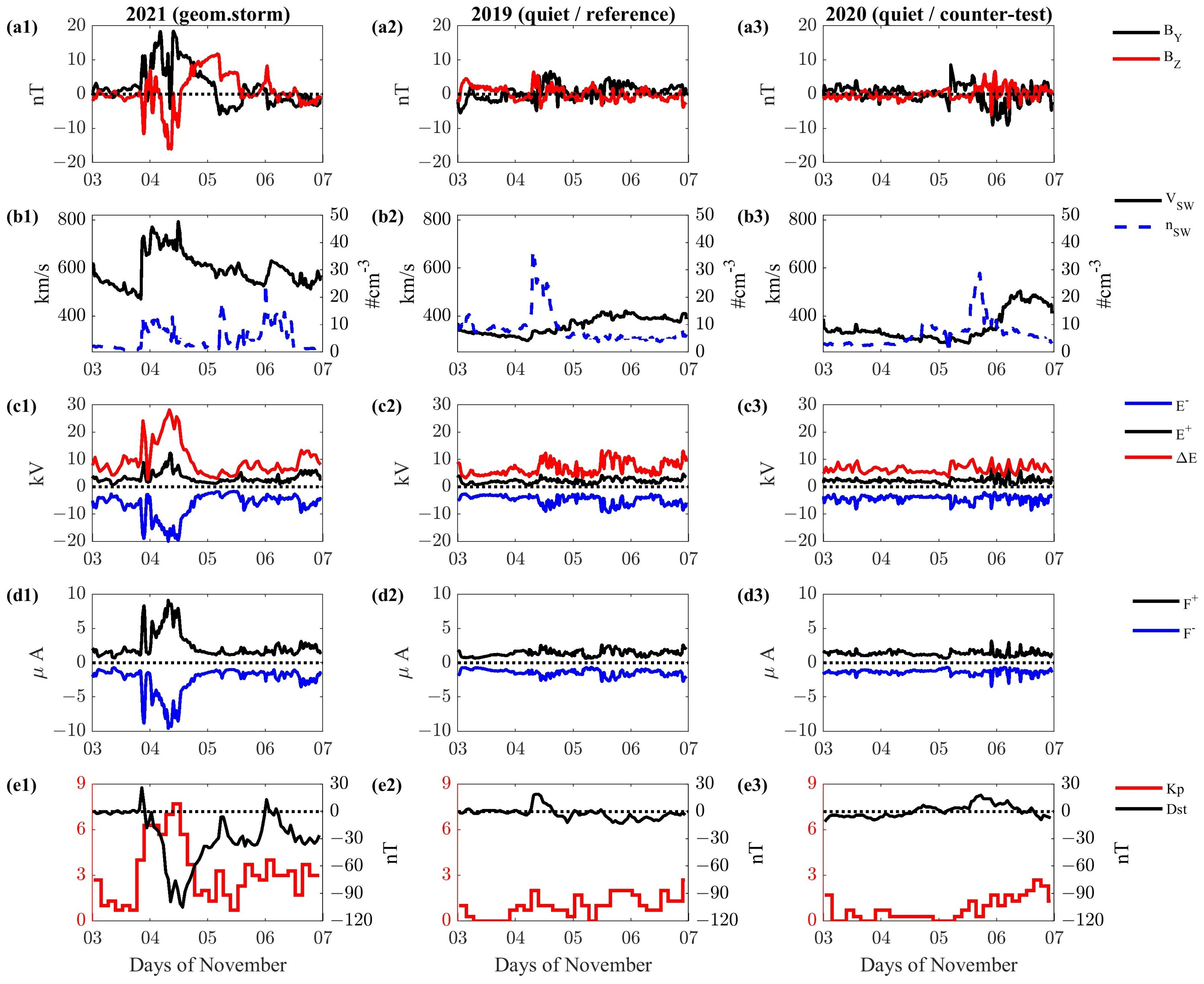


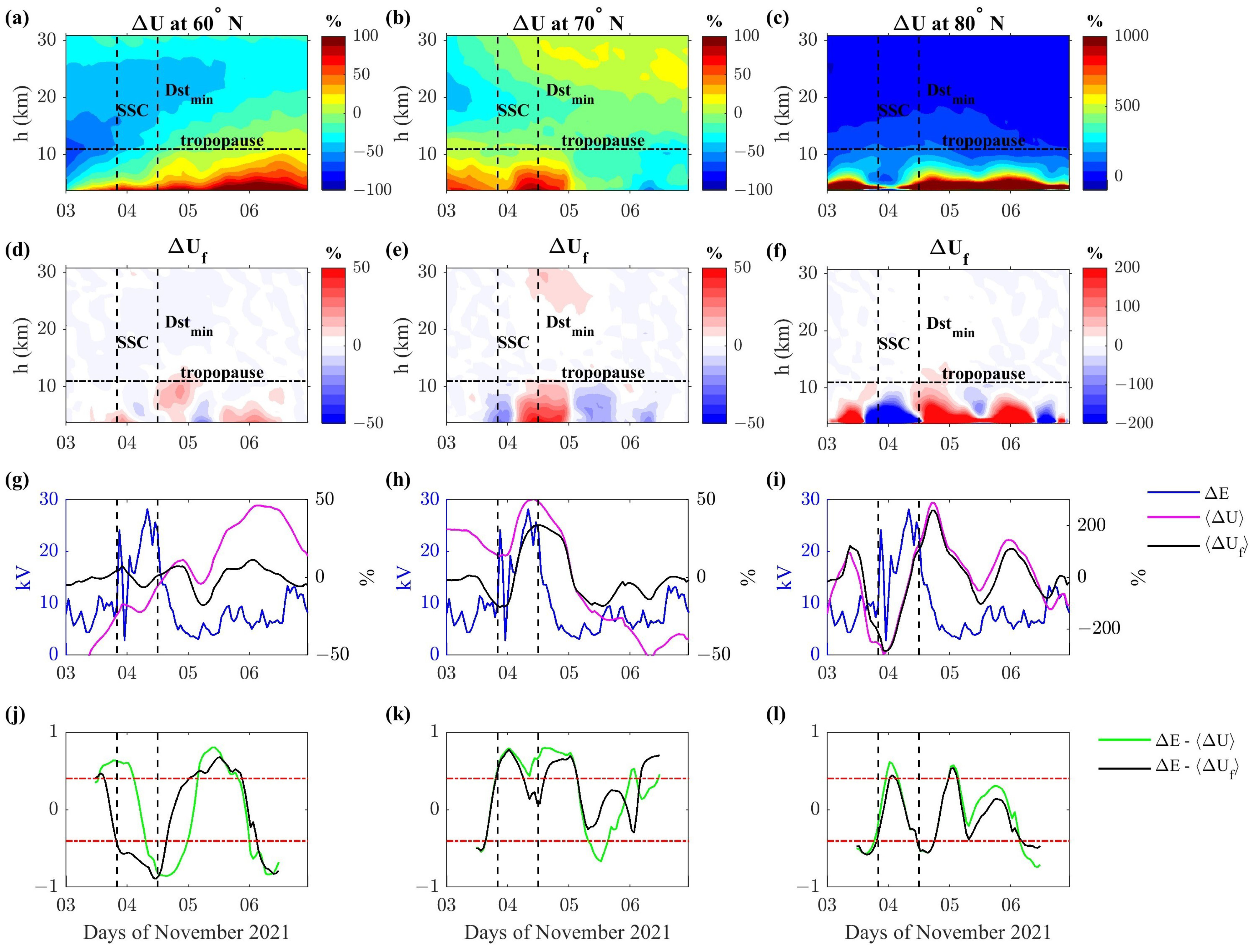

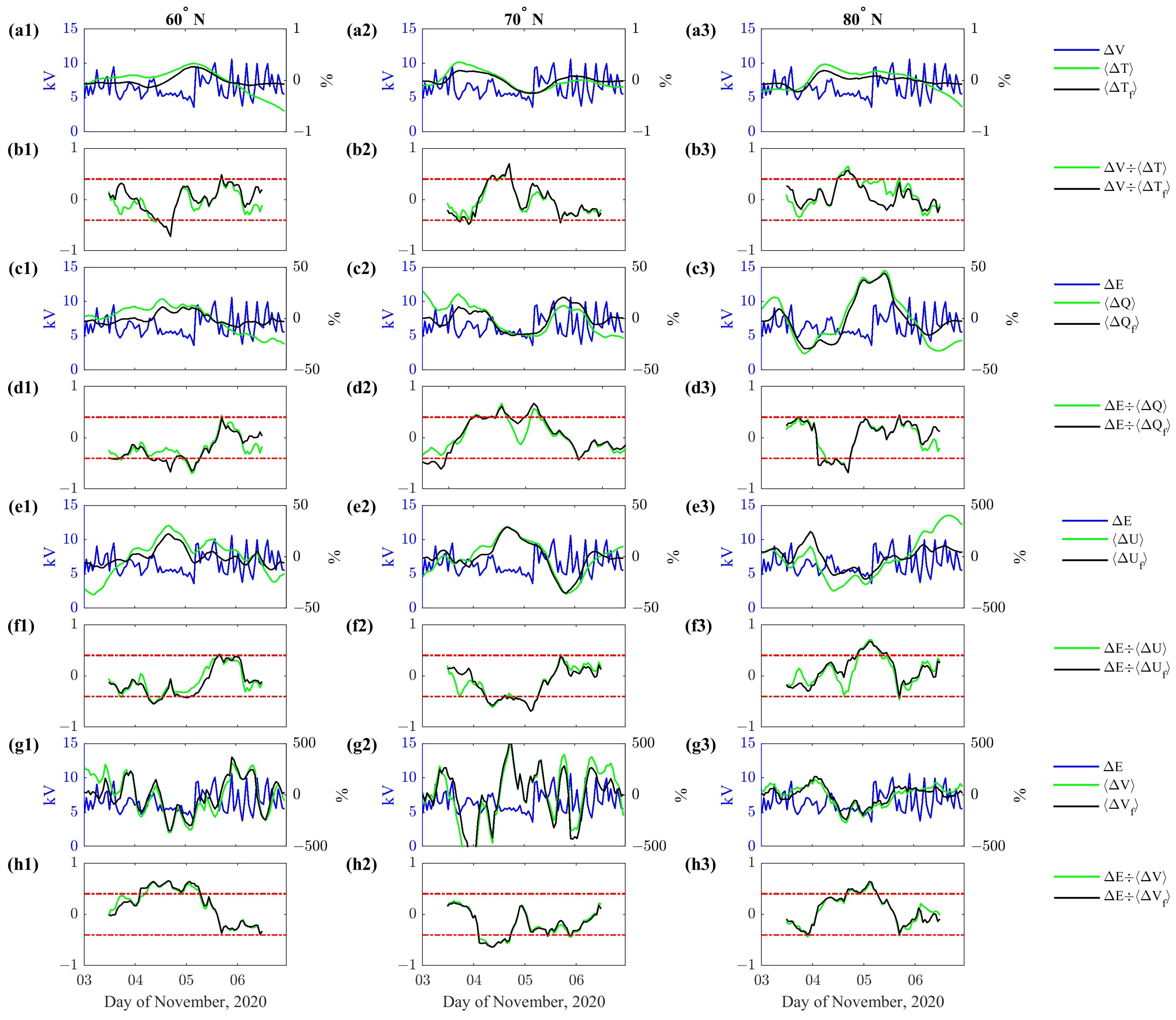

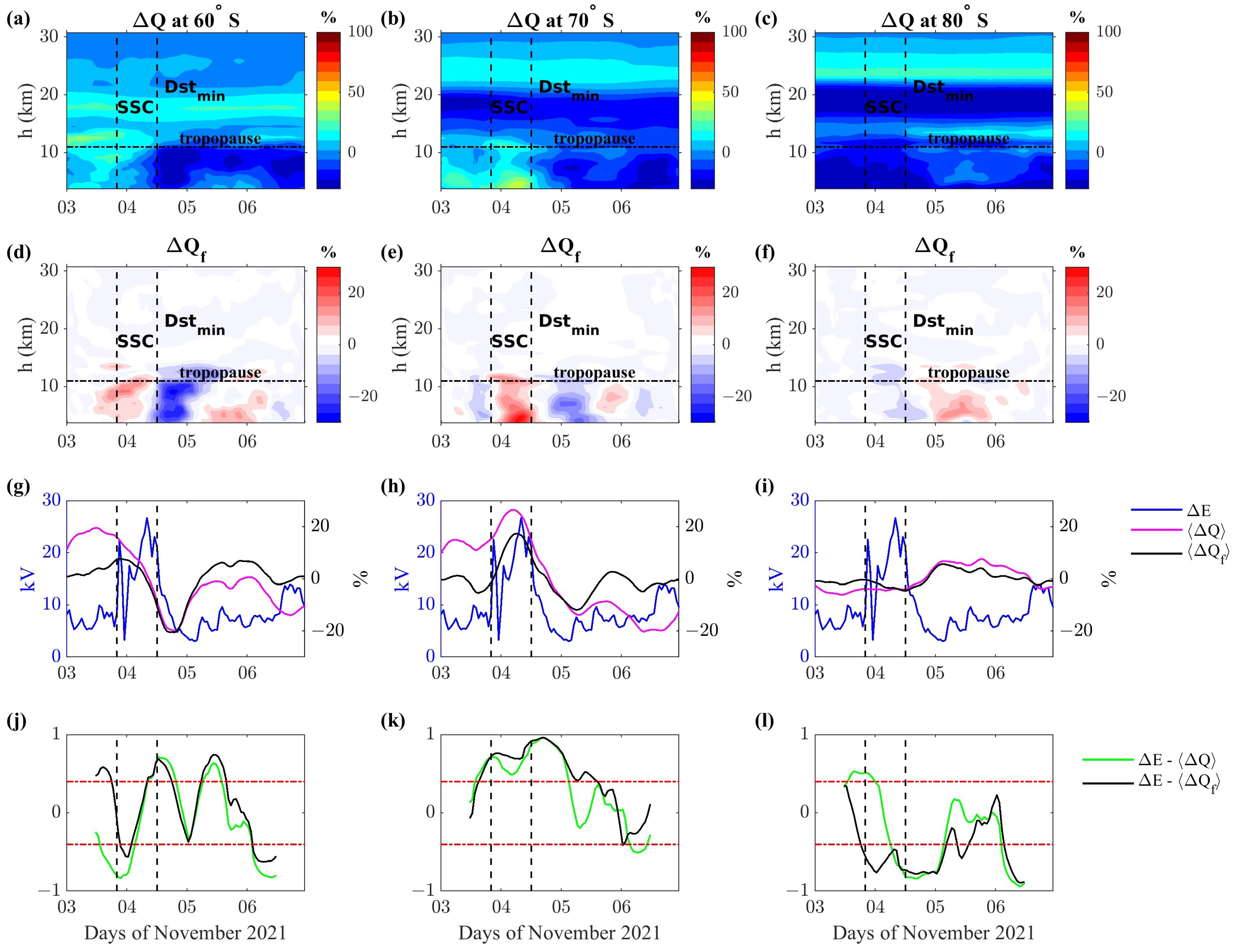
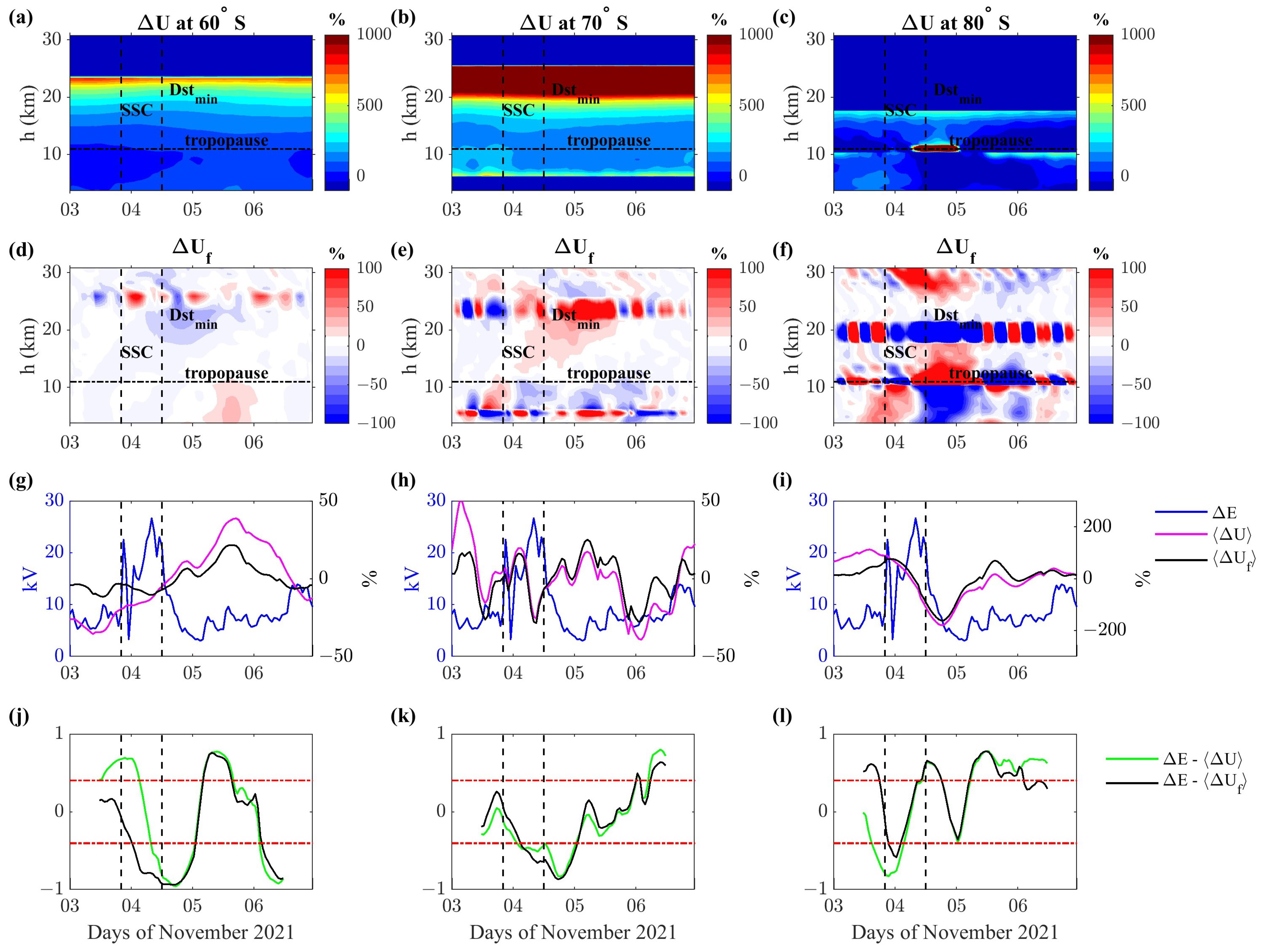
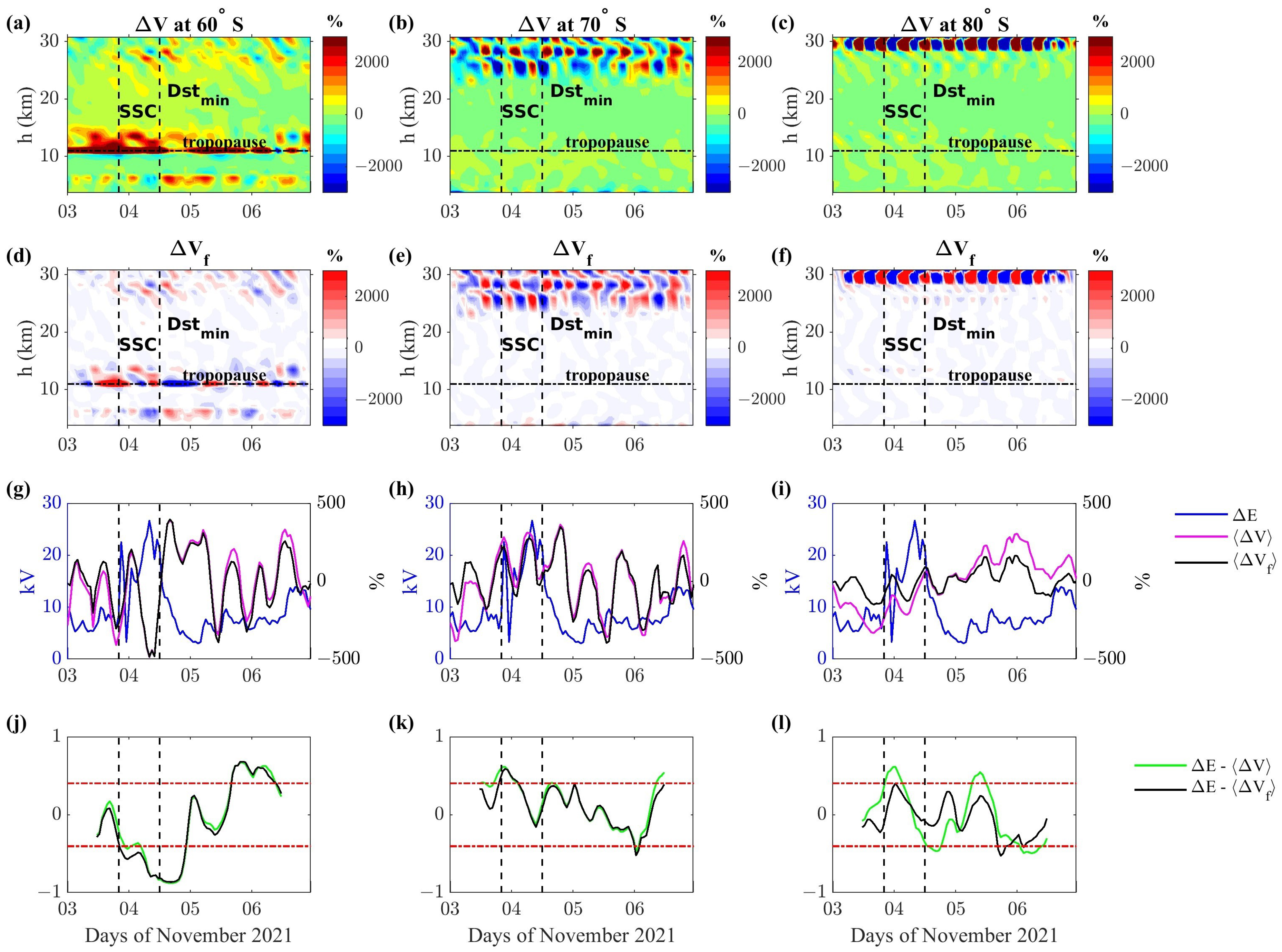
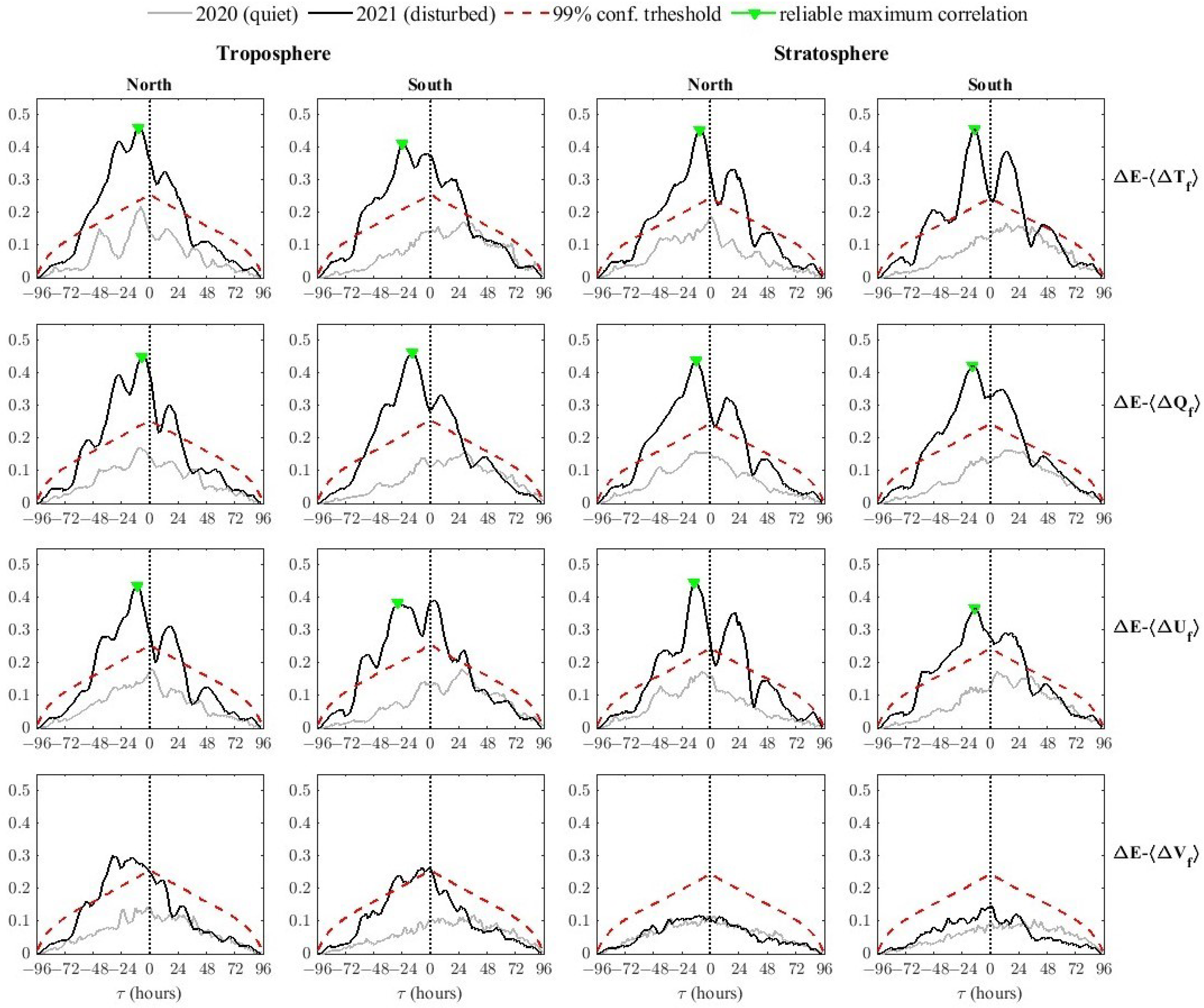
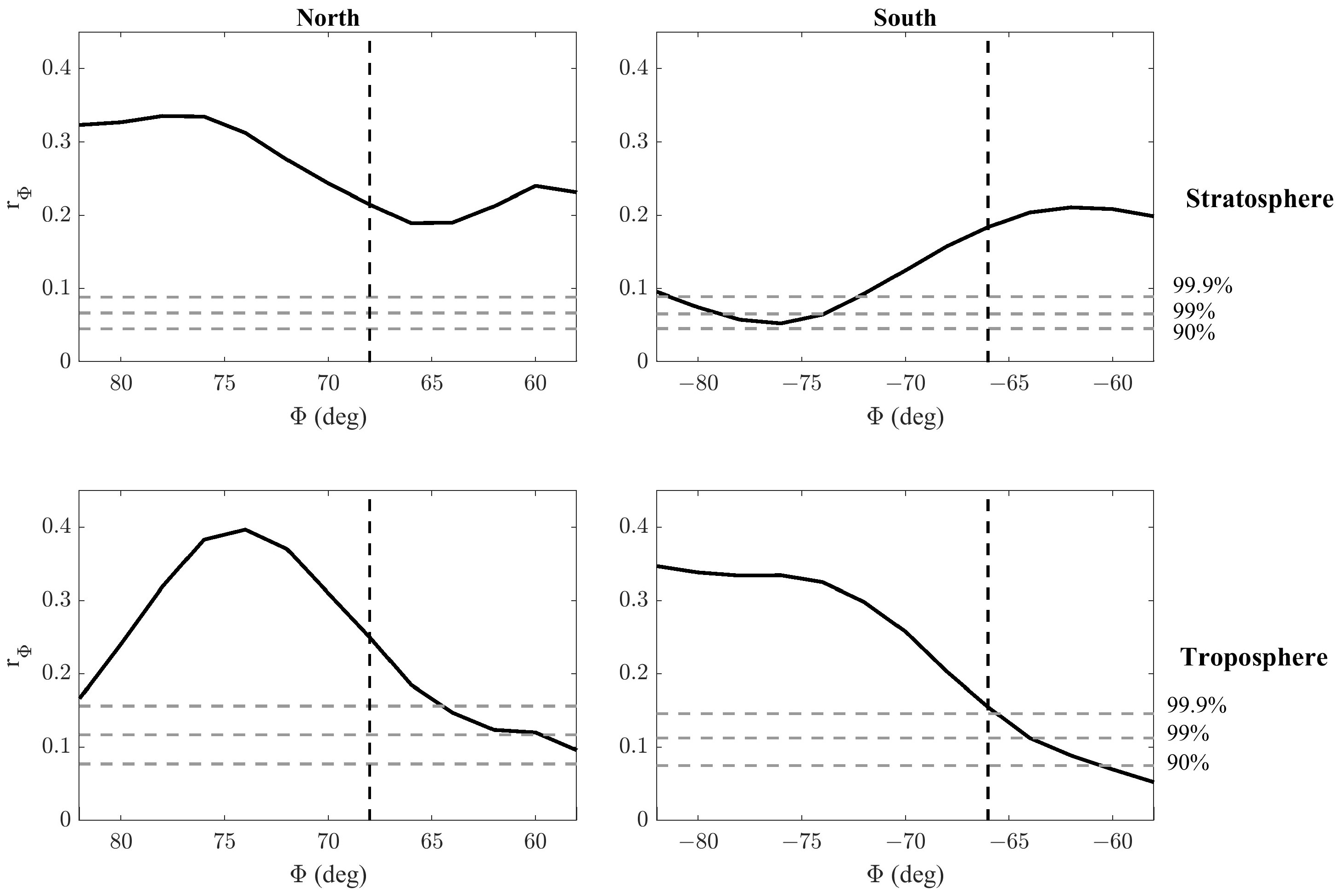
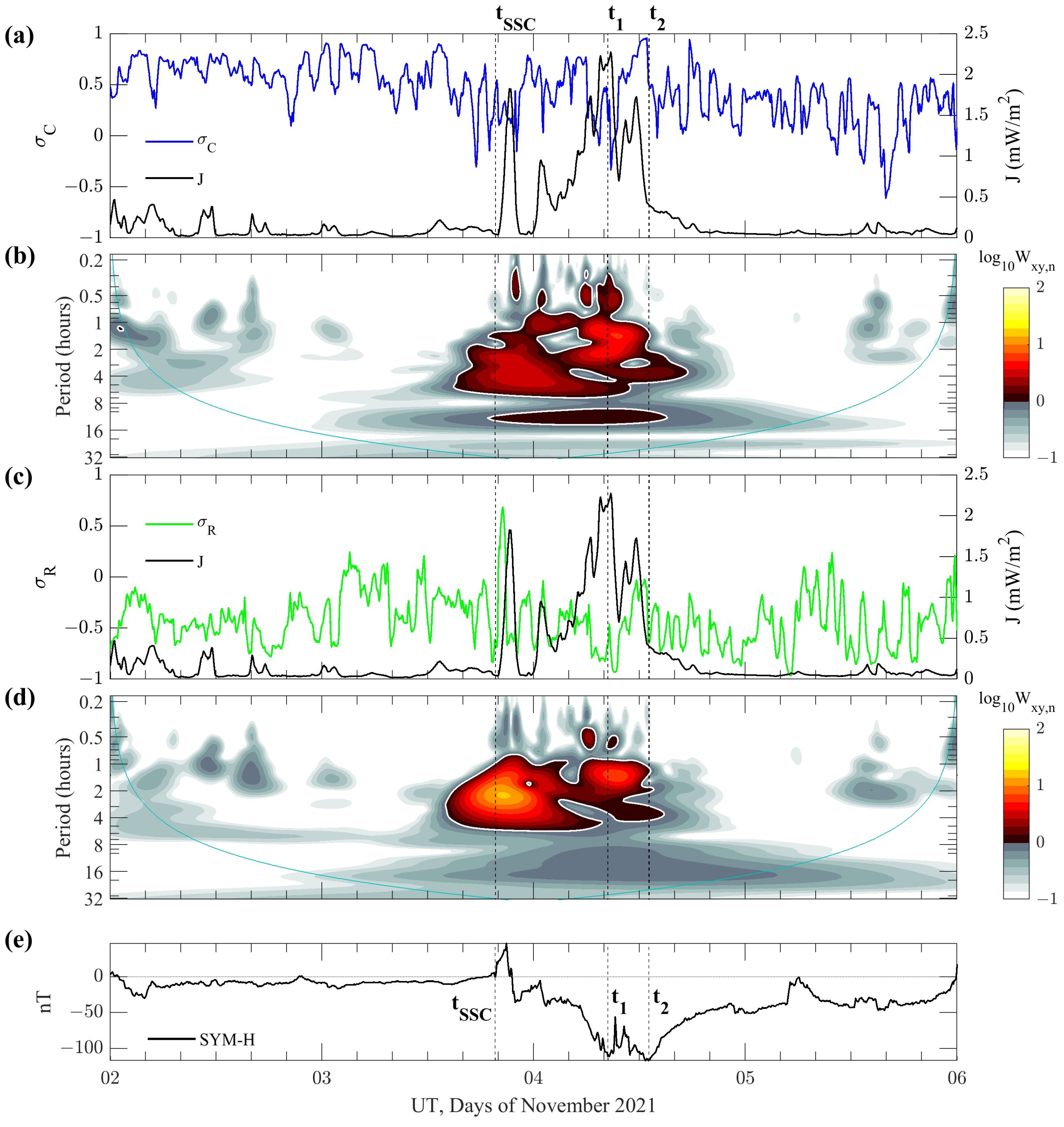
| Northern Hemisphere | Southern Hemisphere | ||||||||
|---|---|---|---|---|---|---|---|---|---|
| Param | (h) | (h) | |||||||
| Atmosphere (troposphere + stratosphere) | T | 0.45 | 0.27 | 0.7 | −9 | 0.42 | 0.26 | 0.6 | −15 |
| Q | 0.43 | 0.27 | 0.6 | −11 | 0.43 | 0.26 | 0.7 | −16 | |
| U | 0.44 | 0.27 | 0.6 | −13 | 0.36 | 0.26 | 0.4 | −14 | |
| Stratosphere | T | 0.45 | 0.22 | 0.6 | −9 | 0.45 | 0.22 | 0.7 | −24 |
| Q | 0.44 | 0.22 | 0.6 | −12 | 0.42 | 0.22 | 0.6 | −16 | |
| U | 0.45 | 0.22 | 0.7 | −14 | 0.37 | 0.22 | 0.4 | −28 | |
| Troposphere | T | 0.46 | 0.20 | 0.7 | −10 | 0.41 | 0.21 | 0.7 | −25 |
| Q | 0.45 | 0.20 | 0.6 | −7 | 0.46 | 0.22 | 0.8 | −16 | |
| U | 0.44 | 0.23 | 0.6 | −11 | 0.38 | 0.20 | 0.7 | −28 | |
Disclaimer/Publisher’s Note: The statements, opinions and data contained in all publications are solely those of the individual author(s) and contributor(s) and not of MDPI and/or the editor(s). MDPI and/or the editor(s) disclaim responsibility for any injury to people or property resulting from any ideas, methods, instructions or products referred to in the content. |
© 2024 by the authors. Licensee MDPI, Basel, Switzerland. This article is an open access article distributed under the terms and conditions of the Creative Commons Attribution (CC BY) license (https://creativecommons.org/licenses/by/4.0/).
Share and Cite
Regi, M.; Piscini, A.; Francia, P.; De Lauretis, M.; Redaelli, G.; Carnevale, G. A Potential Link between Space Weather and Atmospheric Parameters Variations: A Case Study of November 2021 Geomagnetic Storm. Remote Sens. 2024, 16, 3318. https://doi.org/10.3390/rs16173318
Regi M, Piscini A, Francia P, De Lauretis M, Redaelli G, Carnevale G. A Potential Link between Space Weather and Atmospheric Parameters Variations: A Case Study of November 2021 Geomagnetic Storm. Remote Sensing. 2024; 16(17):3318. https://doi.org/10.3390/rs16173318
Chicago/Turabian StyleRegi, Mauro, Alessandro Piscini, Patrizia Francia, Marcello De Lauretis, Gianluca Redaelli, and Giuseppina Carnevale. 2024. "A Potential Link between Space Weather and Atmospheric Parameters Variations: A Case Study of November 2021 Geomagnetic Storm" Remote Sensing 16, no. 17: 3318. https://doi.org/10.3390/rs16173318





